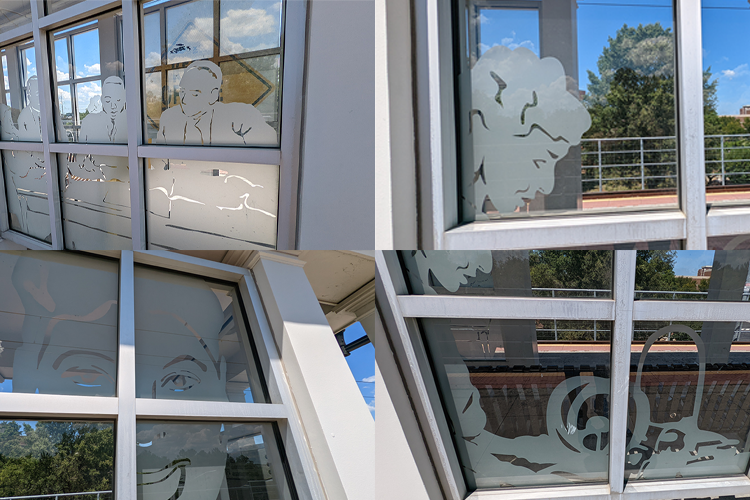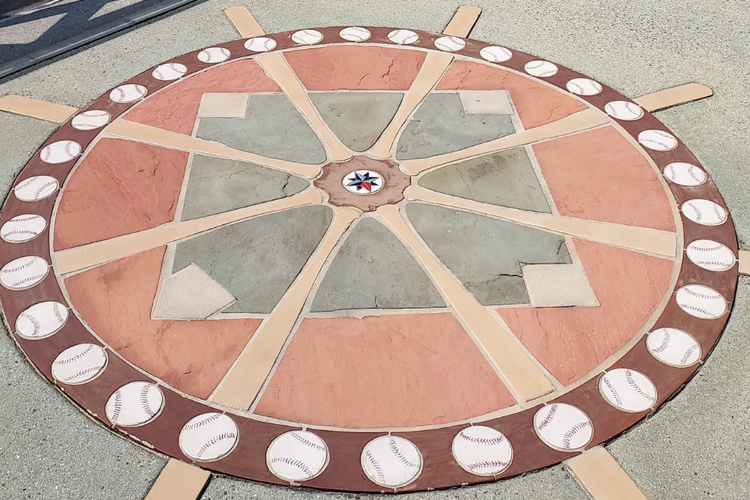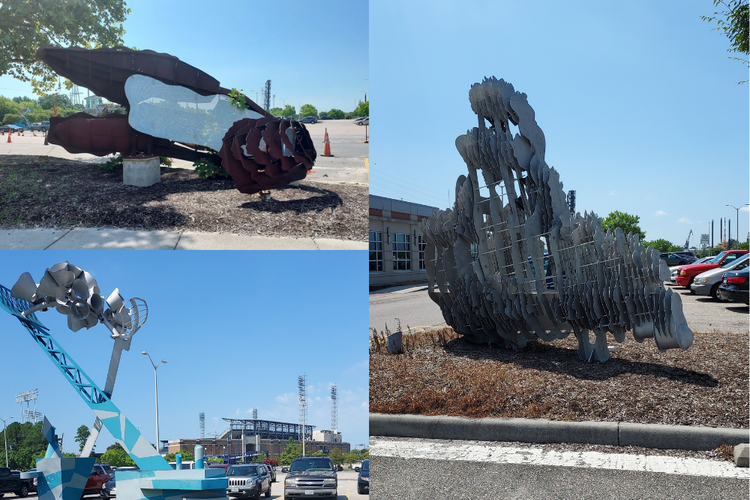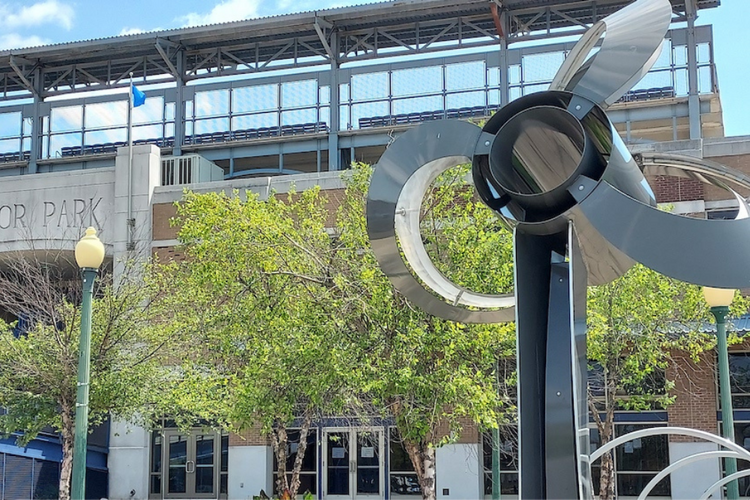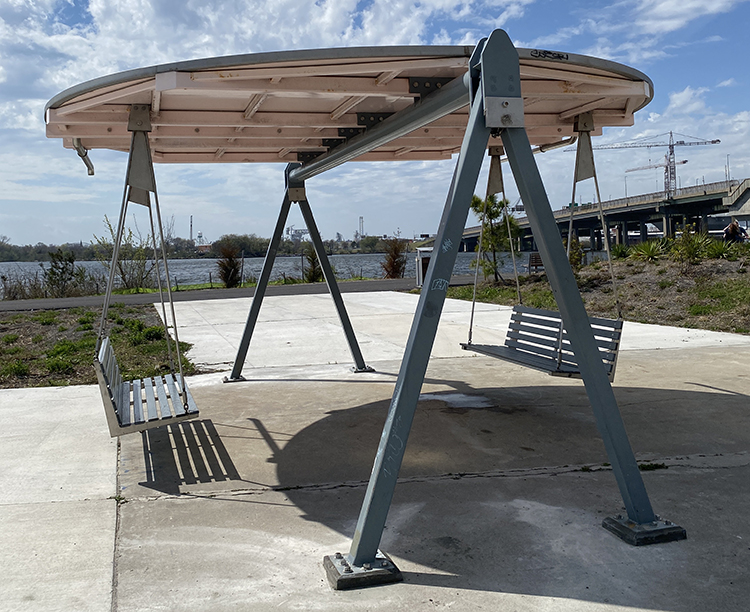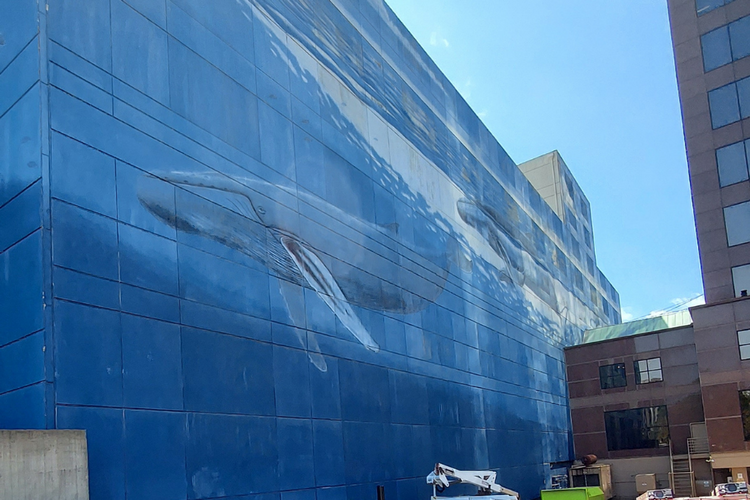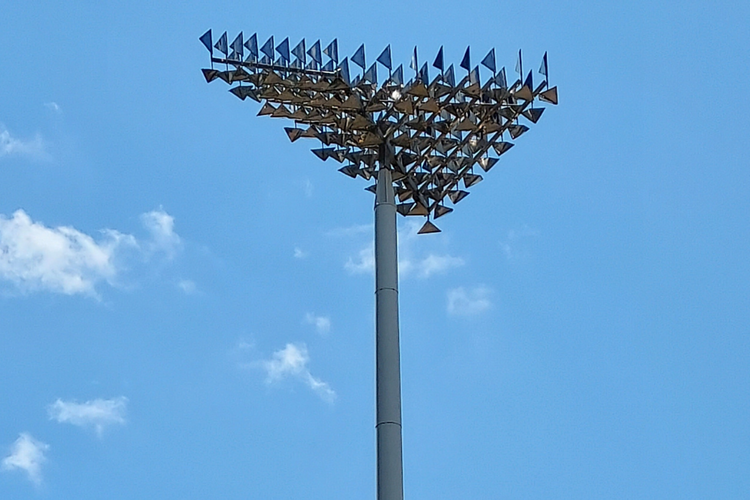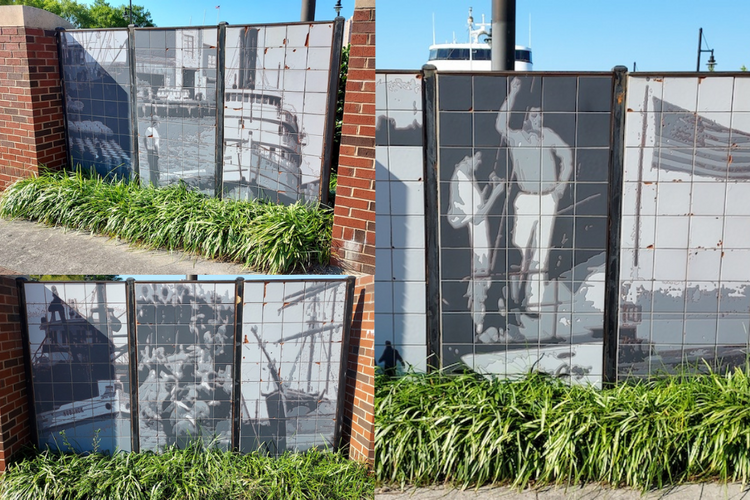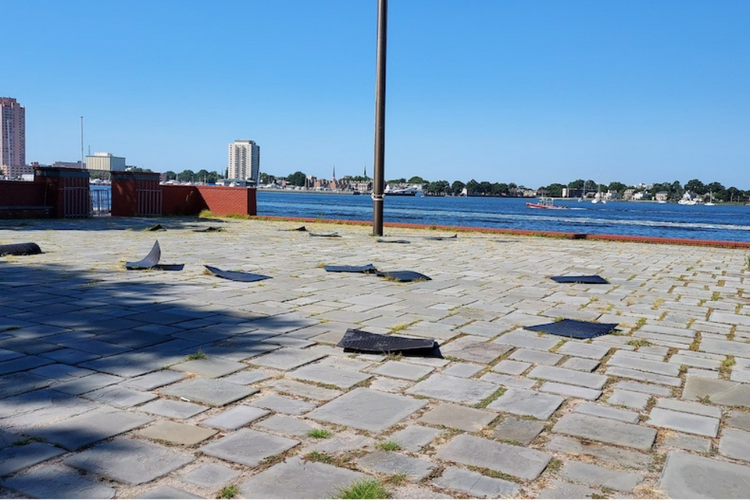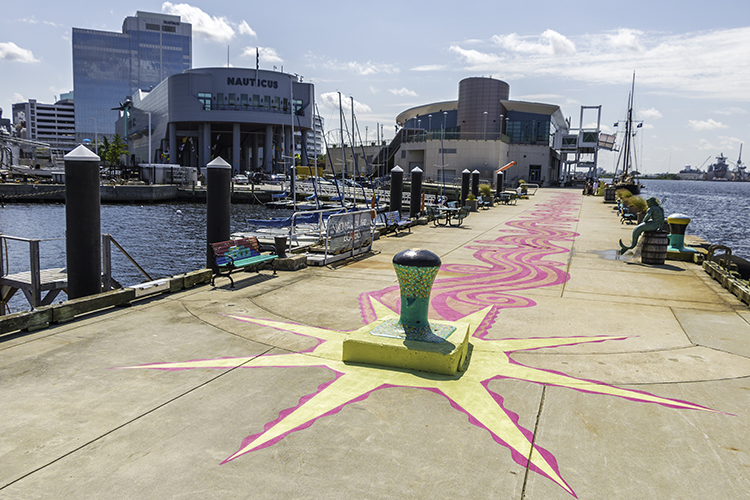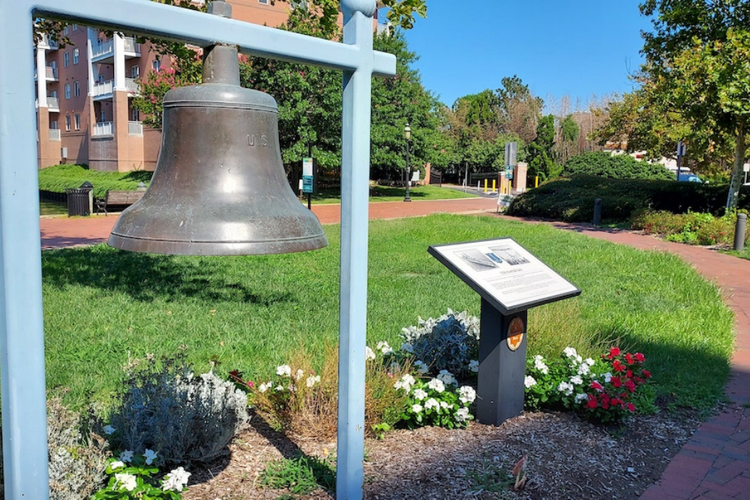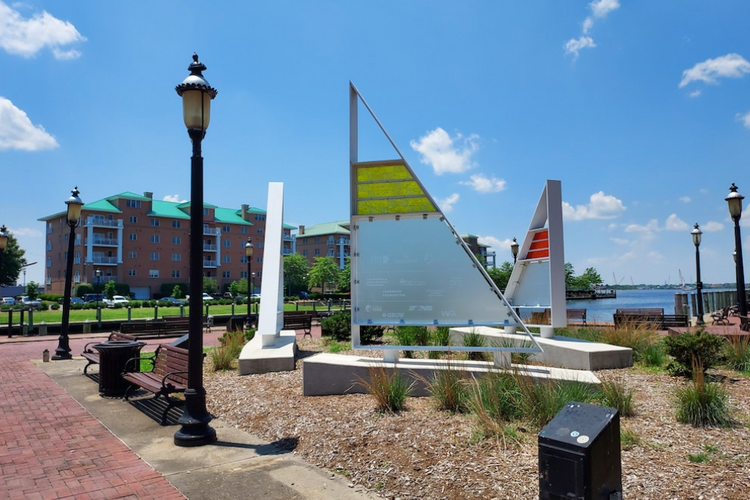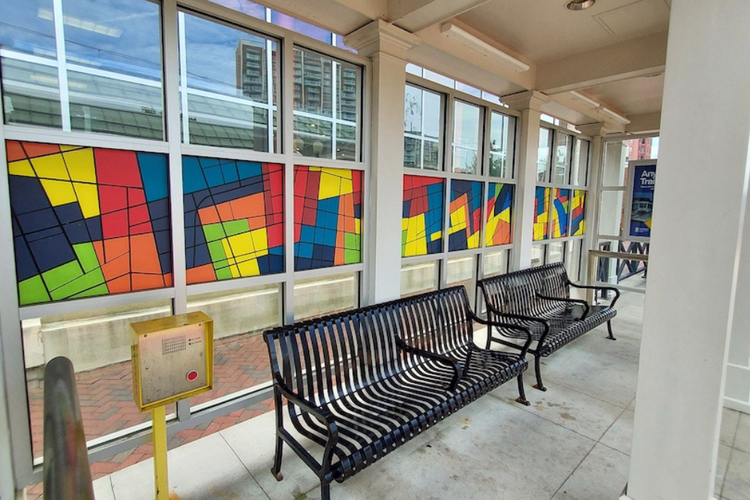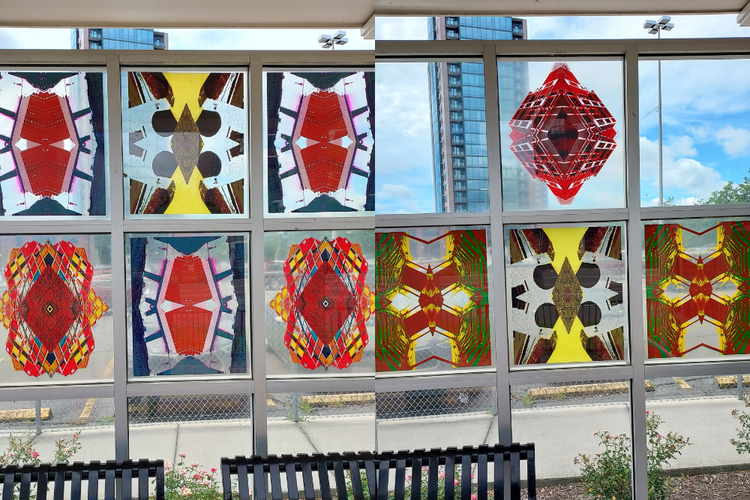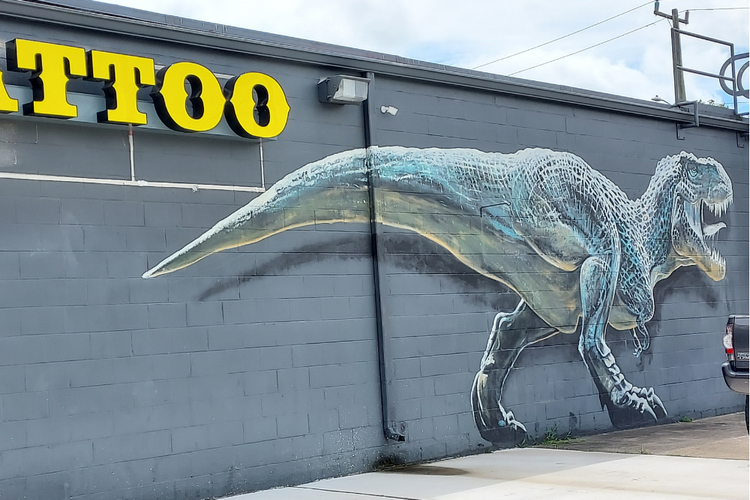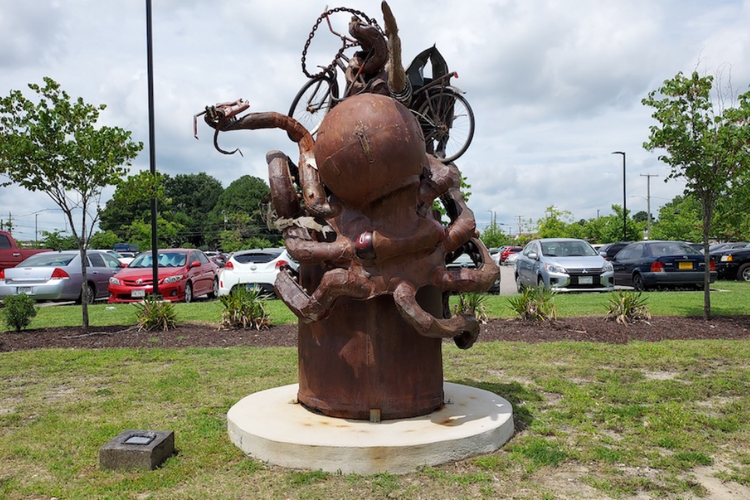THERE IS NO SHORTAGE OF AMAZING ART DISPLAYS ALL ALONG THE ELIZABETH RIVER TRAIL.
Norfolk State Inspiration
Shin Gray (Kyungmi Shin, Todd Gray)
2011
Glass
Norfolk State University Light Rail Station, Park Avenue
Sandblasted glass windscreens and glass mosaics were fabricated from a design inspired by the “Character, Values and Strengths” statement from Norfolk State University as well as the green and gold colors of the historically Black university. Historical photographs from NSU’s History, representing students, faculty, Dr. Lyman Brooks (president 1938-1975), Dr. Strong (First Top Graduating Student) were incorporated into the design of the light rail station on NSU’s campus.
Sailing With the Tides
Abby Silver
2011
Ceramic
Harbor Park Light Rail Station, Park Avenue
Abby Silver was one of approximately a dozen artists whose artwork was selected for installation in the light rail stations as part of the City of Norfolk’s 1% public art program in 2011. The artists were honored at a public dedication ceremony. Then Mayor Paul Fraim was among the speakers who lauded their efforts and emphasized the importance of public art in creating a sense of community.
Seated along the Elizabeth River, Harbor Park stadium is used primarily for baseball and is home to the Norfolk Tides Minor League Baseball team. Abby’s ceramic mosaic combines America’s favorite pastime, baseball, with the strong maritime culture of Norfolk, creating a unique compass or keel from baseball bats.
PLAY BALL
John Rudel
2011
Found/Recycled Material
Harbor Park Light Rail Station, Park Avenue
John Rudel, a local artist and teacher at Virginia Wesleyan College sandblasted photographic images of baseball players in action onto the windscreens at Harbor Park Station. The large scale of the figures and their organic curvilinear shapes are a striking visual contrast from the surrounding hard grid of the aluminum station structure. By isolating the dramatic movements of the players in action Rudel asks the viewer to consider the general beauty and potential of the human act of throwing a baseball.
Rudel states “A very meaningful feedback loop is developed when artists who inhabit a region are invited to become culture creators within that region. That’s exactly what the public art program is facilitating. Being selected to create the glass imagery for Harbor Park station has meant a lot to me and I hope that it is enjoyed by many.”
Harboring Histories (Ship Shell, Signal Carrier, Stealth Reef)
Rhiza A+D (Ean Eldred, Richard Garfield, John Kashiwabara, Peter Nylen)
2015
Found/Recycled Material
IN TEMPORARY STORAGE
Harboring Histories celebrates Norfolk not only as a business and transportation hub but as an arts and cultural destination. The artwork orients travelers and serves as a way finder between the train, the light rail, parking, the river, roadways and downtown. The artwork is enjoyed by train passengers, who often depart and leave at dark and is seen at all hours of the day by downtown commuters, visitors and business people from Richmond and D.C. Baseball patrons, pedestrians, bikers, runners, boaters and perhaps even travelers on the interstate can also experience the public art.
The first corten steel sculpture represents the history of boat building and shipping layered like the outside of an oyster shell. A perforated aluminum interior lining represents the inside beauty of an oyster. The second painted steel sculpture mimics the commonly-seen profile of large ships. A railroad tress and oyster tongs support a reef like collection with railroad signal lights and radar forms on top. The third sculpture is made of aluminum and merges the biology of the Elizabeth River’s natural reef forms with Norfolk Virginia’s great shipping industry.
the pitch
PACT (Laura Freed, Jen Stringer)
2016
Sculpture
Harbor Park, Park Avenue
Located at Harbor Park stadium, home to the Norfolk Tides minor league baseball team, The Pitch is a 16 foot tall, powder-coated aluminum sculpture with changing LEDs. Moreover, the sculpture functions as a bike rack for park visitors. The sculpture references a traditional ship propeller, celebrating Norfolk’s remarkable nautical history and lively waterfront community.
A series of graduated rings sit adjacent to the propellor, designed to suggest the movement of water behind a rotating propellor. Biking is popular along the nearby Elizabeth River Trail and the sculpture fills a park void providing a quality bike parking area. The sculpture comes to life at night with dynamic color-changing LED lights integrated into the propellor blades.
UPPER BLUSH
MATTHEW GELLER
2016
SCULPTURE
WATER STREET OPEN SPACE
In 2016, the City of Norfolk Public Art Commission received a National Endowment for the Arts Our Town grant to create public art addressing a community issue in Norfolk’s NEON District. New York-based artist Matthew Geller created a large water-collecting swaying bench sculpture to bring awareness to Norfolk’s relationship with sea-level rise and flooding. In 2023, the sculpture was relocated to a new home along the Elizabeth River Trail in the Water Street Open Space with views looking out over the Elizabeth River.
humpbacks off the virginia coast
Robert Wyland
1993
Mural
999 Waterside Drive
In 2008, twenty-seven years after Wyland’s quest began, the artist and the Wyland Foundation completed the monumental goal of painting 100 life-size public marine murals. These murals were painted in life-size dimensions to increase appreciation and understanding for aquatic habitats and the life within. Perhaps, most importantly, they have reshaped attitudes about marine life conservation.
“We know now that water connects all the countries of the world,” Wyland says. “Our goal with these projects over the last three decades has been to convey the urgency of conservation issues to the public. The health of our ocean and waterways are in jeopardy, not to mention the thousands of marine animals and plants that face extinction if we do nothing.”
The completed “Wyland Walls” campaign is one of the largest art-in-public-places projects in history, spanning five continents, 17 countries, and 79 cities around the globe.
regatta (tower of lights)
William Wainwright
1976
Sculpture
999 Waterside Drive
This artwork is a triangular, stainless steel form composed of hundreds of small triangular pieces of polished steel on a tall tapered pole. The small triangles move with the breeze and catch significant light. The work is integrated into the amphitheater plaza, echoing a geometric step and ziggurat design..”
waterwork
Stephen Farley
2009
Found/Recycled Material
Town Point Park, 113 Waterside Drive
Waterwork, the first 1% for public art project in Norfolk, is comprised of 24 large-scale photographic murals on glazed ceramic tiles. Scenes of work and life on the Norfolk waterfront selected from the archives of the Slover Sargeant Memorial Collection are depicted to remind visitors of the rich history and continuing work traditions of the Norfolk waterfront. Images include tugboats, battleships, sailboats, skiffs, dock buildings, a baptism from the 1800s, a day the Elizabeth River froze, rescues, ferries, freighters, longshoremen, sailors, flags, and more.
armed forces memorial
Maggie Smith, James Cutler
1998
Bronze
Town Point Park, 113 Waterside Drive
Scattered across a contemplative plaza area along the waterfront at Town Point Park in Downtown Norfolk as if blown by the wind, sits the Armed Forces Memorial. Spanning 160-foot, the monument consists of 22 cast bronze letters depicting actual text written to loved ones by members of the Armed Forces who never returned from war. Erected in the summer of 1998, the memorial is dedicated to veterans of American conflicts from the Revolutionary War to the War in Afghanistan. Designed by James Cutler and Maggie Smith, the artists searched for voices to convey diverse emotional experiences.
In April 2020, 2 new letters were added to commemorate soldiers who served in Iraq and Afghanistan. Maggie and James state “In remembering those who served in Iraq and Afghanistan and lost their lives, we were able to highlight two things previously unrepresented in the memorial: the first, the loss of mothers in combat who left young children; and the second, a soldier’s view of the toll war takes on civilians.”
homecoming
Stanley Bleifeld
1986
Found/Recycled Material
Town Point Park, 113 Waterside Drive
Town Point is where Norfolk began. In 1680 the General Assembly of his Majesty’s Colony of Virginia enacted a law requiring each county to establish and develop a town site. In lower Norfolk County fifty acres of land at the entrance of the eastern branch of the Elizabeth River were purchased from Nicholas Wise, thus assuring the town of good water access to the surrounding areas. County surveyor John Ferebee, laid out Front Street (now Main Street) on high ground and the town was divided into half-acre sites for dwelling houses and warehouses.
This larger than life statute of a US Navy sailor being greeted by his family upon return from sea duty has particular significance because it was dedicated the same week the crew of the USS Cole returned to Norfolk, Va following the terrorist attack in Yemen. The statue is a frequently visited project just a few steps from the Armed Forces Memorial located on the other side of Nauticus along the Elizabeth River.
magenta line
Richard Nickel and Aimee Bruce
Mural
Nauticus Pier, 1 Waterside Drive
A once concrete grey dock became a canvas for local artists Rick Nickel and Aimee Bruce in 2018. Beautifully painted bright orange and pink on the spacious dock behind Nauticus and the Battleship Wisconsin is a pier-length mural, the Magenta Line. Named in reference to a navigational guide affectionately called the Magenta Line on the Intracoastal Waterway nautical charts, the mural also marks the spot of Mile Marker Zero on the ICW. With hand-painted benches lining the dock, it makes for the perfect picnic spot. The Elizabeth River Trail Foundation commissioned the mural in partnership with Nauticus in 2018.
lone sailor
Stanley Bleifeld
2001
Bronze
Wisconsin Square, 215 Brooke Avenue
The work is a life-sized sailor and duffel bag in cast bronze, edition and signed in 2001. The two elements sit separately on cast ferroconcrete plinths. The work is on a brick plaza surrounded by 10 plaques on granite bases.
The Lone Sailor© statue represents the past, present and future Navy bluejacket – adventurous, independent, courageous, self-reliant, and resourceful. His authentic image evokes the lure and romance of service at sea. The dedication of The Lone Sailor© statue occurred on May 25, 2002. The statue is on Wisconsin Square facing the bridge of the Battleship Wisconsin. Because Norfolk is the home of the U.S. Atlantic Fleet, it serves as a natural home for The Lone Sailor©. The Norfolk statue is surrounded by eight bronze commemorative plaques of Norfolk-based ships and submarines that have met with tragedy—and one plaque that recalls the 9/11 terrorist attack on the Pentagon. The plaques are: USS Cole, USS Forrestal, USS Iowa, USS Liberty, USS Nimitz, USS Newport News, USS Scorpion, and The Pentagon. The Norfolk Lone Sailor©, and its moving site were donated by “Friends of the United States Navy Memorial”—made up of hundreds of individuals and local organizations that pledged their support.
uss norfolk bell
Unknown
1975
Bronze
Wisconsin Square, 215 Brooke Avenue
The USS Norfolk, Destroyer Leader 1 was commissioned at the Philadelphia Naval Yard on March 4, 1953. The wife of former Norfolk Mayor Fred Duckworth served as the ship’s sponsor. Following the decommissioning of the USS Norfolk, the ship’s bell was on display at the foot of St. Paul’s Boulevard from 1975 until 1987. It is now located in Wisconsin Square, near Harbour Place Condominiums. The giant brass bell is one of the last remaining pieces of the destroyer Norfolk. Two of the USS Norfolk’s anti-aircraft gun mounts are on display at a high school in Boca Raton, Florida. The rest of the ship was sent to the scrap heap in 1974.
elizabeth river trail donor sculpture
Ellenburg & Shaffer
Glass/Metal
2020
Pagoda & Oriental Garden, 265 W. Tazewell Street
Just outside the Pagoda & Oriental Garden, on the promenade in Freemason Harbor, sits three glass sails that appear to ripple in the breeze off the Elizabeth River. You will notice names and logos etched into the clear glass, each in recognition of a significant contribution to the Elizabeth River Trail. As a thank you to the first donors of the Elizabeth River Trail Foundation, local glass artists George Ellenburg and Avery Shaffer were commissioned to memorialize this generosity in a highly visible and iconic location along the trail. The three triangular shapes encased in steel were inspired by the sails and nautical flags seen nearby on the river. The artists, foundation and many donors cut the ribbon for the sculpture in the summer of 2020.
freemason composition in primary
Crystal Warlitner
2011
Glass
York Street/Freemason Light Rail Station, York Street
Located at an entry point to the Freemason historic district, the light rail station artwork promotes the continuity and character of the neighborhood. Specifically, the art reflects a mix of both the historic charm and the urban energy and vitality associated with the area and its residents. The oldest existing houses in the Freemason Historic District were built in the 1790’s. Several other remaining homes and carriage houses were built between the 1840’s and the 1880’s. The bulk of the remaining older homes were built in the late nineteenth and early twentieth centuries, each offering a different interpretation of building design during the Victorian era. In the early 1970’s, several businesses and individuals were captivated by the charm of the quiet, tree-lined, cobbled streets and elected to work or live in the neighborhood. That trend continues as the neighborhood’s boundaries become surrounded by new townhouse and condominium developments built on land formerly housing piers, a molasses tank, cold storage units, and warehouses.
getting on your optic nerve
Clay McGlamory
2011
Glass
Eastern Virginia Medical Complex Light Rail Station, Brambleton Avenue
Clay’s windscreen artwork for the EVMS Light Rail Station works with the architecture of the historical buildings and grounds, using kaleidoscopes as a theme and basis for the installation. His plan was to push the kaleidoscopic qualities and the possibilities of structural construction while energizing the compositions with color manipulation. After many variations for the grid of 27 panels, Clay settled on the with the best flow, rhythm and visual vibration. The final piece references the many photographs the artist took as he researched Fort Norfolk. The transparency of the printed ink layers and non-printed negative space panels allows plenty of light to pass through keeping the work from being too heavy.
t-rex
Athena and Sean Karn
Mural
Otzi Tattoo Agency, 1130 Boissevain Avenue
Painted by the tattoo artists from family-run tattoo parlor, Otzi, this mural has become an icon of the Chelsea neighborhood. T-Rex watches over a busy trail intersection, with cyclists, walkers, strollers and beer enthusiasts all making their way across Claremont Avenue to their trailside destinations.
release the kraken
Bage
2021
Found/Recycled Material
Chelsea, Raleigh Avenue and Claremont Avenue
The Elizabeth River Trail Chelsea Public Art committee selected Norfolk artist Bage to create an artwork that speaks to the progressive, creative vibe of Chelsea to serve as a gateway, or point of transition between the trail and the neighborhood.
The 10ft. legendary cephalopod-like sea monster sculpture is constructed of a recycled buoy with bowling balls for eyes. A school of fish created of stainless steel encircles the sculpture. Bikes and other commonly seen items along the recreational trail appear as captured prey. Materials reference the nearby shipyard such as boat flooring that forms the soles of a pair of boots created entirely of scrap metal. Cut pipes line the arms to form suckers. Rumor has it a tooth lost during construction may be buried inside.
the future is in the margins
DeeDee Morrison
2021
Sculpture
Larchmont Library, 6525 Hampton Boulevard
Deedee Morrison combines history, art and innovation to create site-specific public art that fosters a unique sense of place. The artwork is a story of the majesty and vulnerability of the Elizabeth River watershed and all coastal wetlands.The Larchmont portion of the Elizabeth River Trail is a picturesque transitional gateway. Heavily used by neighboring residents for exercise and as a gathering spot, it’s an entry point for the trail and features a parking area.
The center panel is a polyurethane cast resin panel of the entire Elizabeth River watershed which is 64,000 square miles. The adjacent Corten and hand-forged stainless steel panels incorporate several of the local wetland species that are working for us on the frontlines every day. The artwork is situated on three 6’x2.5′ rectangular, concrete bases left from a previous public art project, the Mission 22 War at Home memorial, which honored fallen veterans from every conflict in our nation’s history.


